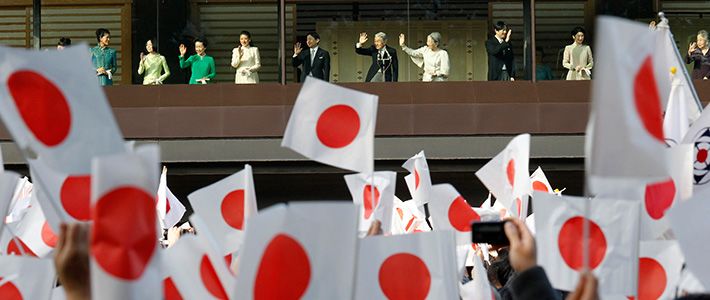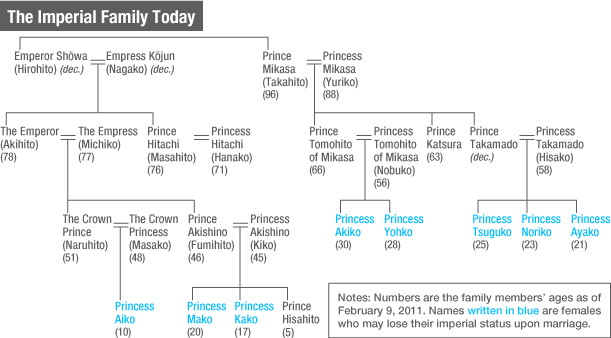
Issues for Japan’s Imperial Family
Politics- English
- 日本語
- 简体字
- 繁體字
- Français
- Español
- العربية
- Русский
In November 2011, the administration of Prime Minister Noda Yoshihiko announced it would begin considering legal steps to create imperial branch households headed by women, a step that would allow female members of the imperial family to remain in the family even after marriage. The current Imperial Household Law states that a female member of the family loses her royal status when she marries outside the imperial family. Today there are nine members of the imperial family under 30 years old, but the only male is five-year-old Prince Hisahito, the youngest member of the family. The eight-to-one ratio of females to males is extraordinarily unbalanced. What is more, six of the eight women are already of adult age, which means they are likely to get married and leave the imperial family in the near future. This threatens to lead to a situation in which the imperial family is so reduced in numbers that it is unable to fulfill all its duties. The Imperial Household Agency, which handles the affairs of the emperor and his family, requested the cabinet’s attention to this as a matter of some urgency.

The Imperial House System Today
The imperial family now numbers 23 people: Emperor Akihito and Empress Michiko, Crown Prince Naruhito and his family, Prince Akishino (Fumihito) and his family, and various other members. Article 1 of the Constitution of Japan spells out the symbolic nature of the system: “The Emperor shall be the symbol of the State and of the unity of the People, deriving his position from the will of the people with whom resides sovereign power.” Article 2, meanwhile, defines the throne as dynastic, and therefore subject to succession according to bloodline. The constitution restricts itself to these fundamental principles, however, leaving the details to the Imperial House Law.
This law spells out the system of succession, the makeup of the imperial family, the establishment of a regency when necessary, the nature of the Imperial House Council, and other matters. Succession is limited to male offspring in the male line, meaning that female members of the imperial family cannot sit on the Chrysanthemum Throne. The law places priority on primogeniture and direct descent in defining the order of succession. Following Emperor Akihito, who now occupies the throne, the line of succession is: (1) Crown Prince Naruhito, (2) Prince Akishino, (3) Prince Hisahito, (4) Prince Hitachi (Masahito), (5) Prince Mikasa (Takahito), (6) Prince Tomohito of Mikasa, and (7) Prince Katsura (Yoshihito). Males in the imperial family are classified as shinnō (sons and grandsons of an emperor) or ō (great-grandsons and later generations), while females—including spouses originally from outside the family and widows—are either naishinnō (the emperor’s daughters and granddaughters) or joō (great-granddaughters and below).
The current Imperial House Law defines all offspring born into the imperial family as royalty according to a system of permanent membership. The marriages of imperial males must be approved by the Imperial House Council, which includes two members of the family as well as leaders of the three branches of government—the presidents of the two houses of the Diet, the prime minister, and the chief justice of the Supreme Court of Japan. Once the council approves the marriage, the wife assumes royal status as well. Marriages of female members of the family, on the other hand, require no approval by the Imperial House Council. This means that as things stand, there is no means to prevent these women from losing their royal status when they reach marriageable age and leave the family.
Efforts at Reform
Prime Minister Noda’s plan to introduce imperial branch houses with women as their heads will require partial amendment of the Imperial House Law. Another attempt at amendment took place in 2005, when Prime Minister Koizumi Jun’ichirō made serious efforts to bring lasting stability to the imperial succession. In late November that year, the Advisory Council on the Imperial House Law issued its final report, in which it concluded that “eligibility for the Throne must be extended to Imperial Family members who are female or of female lineage.” This sparked a backlash from conservative groups on the grounds that descent through the male line was a tradition of Japan’s imperial family. These groups organized protests around the country and managed to get a third of the Diet to sign a statement urging the prime minister to move more prudently.
Koizumi’s government enjoyed strong public support at the time, and when the Diet convened for its ordinary session in January 2006, the prime minister announced his intention to present a bill amending the Imperial House Law based on the recommendations in the advisory council report. In early February, though, media reports that Princess Akishino was pregnant forced him to abandon this plan. In September that year, she gave birth to Prince Hisahito—a welcome addition to the imperial family, being the first male born into it since his father’s birth 41 years earlier.
The birth of this new shinnō apparently convinced the Japanese public that the succession problem was solved. The Imperial Household Agency, however, has indicated that issues remain to be addressed. Today the imperial family includes six princely houses, but this number could be reduced in the near future as elderly princes pass away and younger female members lose their royal status upon marriage to commoners. It was in response to this situation that the Noda administration began to look into establishing distaff branches within the imperial family late last year.
What the Distaff Houses Would Achieve
These distaff branches would be something unprecedented in Japanese history: self-supporting princely houses formed around women, who would remain in the imperial family after marriage. Because they would be entirely new creations, very careful consideration must go into their planning. Conservative groups are already marshaling their counterarguments, suggesting lightening the workload of the imperial family to cope with dwindling numbers, or increasing the number of eligible nobility by reinstating the male-lineage collateral houses that were stripped of their royal status by the Occupation authorities following World War II. Those who defend the male-lineage tradition also worry that establishing distaff houses might eventually lead to acceptance of female lineage succession to the throne.
If the true goal of creating distaff branch houses is to ensure the stable continuity of the activities of the imperial household, it should involve no amendment to the portions of the Imperial Household Law defining eligibility for and succession to the throne. Any amendment should be limited to Article 12 and other relevant sections of the law, to allow females to remain members of the imperial family after marrying commoners. It may be best to include a proviso that these branches would retain royal status for one generation only and would confer no right of succession to the throne to the women who head them. As far as any reduction in imperial duties is concerned, such duties are not mandated by any law, and ultimately a decision on this matter must be taken according to the wishes of the emperor himself.
As noted above, some conservative groups prefer the idea of restoring royal status to male descendants of the male-lineage collateral houses that were abolished in 1947. Others want to allow the princely houses to adopt sons of direct male-line descent from those collateral houses. Amending Article 9 of the Imperial House Law, which currently forbids members of the imperial family to adopt children, could thus bring new males into the family. But these steps would result in frequent changes to the order of succession to the throne, depending on the ages of the new male members and which house they were adopted into. Seeking husbands for the imperial princesses from among the collateral houses, and granting them royal status upon their entry to the family, would be a more realistic approach. But taking steps like this to preserve the male lineage could lead to infringement of constitutional rights, specifically with respect to Article 14, which states that “All of the people are equal under the law” and that “Peers and peerage shall not be recognized,” and perhaps even Article 24, defining marriage as “based only on the mutual consent of both sexes . . . with the equal rights of husband and wife as a basis.” Special legislation may be required to get around these obstacles. In any case, there is no need to alter the imperial succession that currently runs down to the young Prince Hisahito, and we should not look to expand eligibility to the throne to the female lineage.
The formal duties of the emperor of Japan and other members of the imperial family are highly systematized. Simply taking steps to reduce these activities could produce a lack of balance in the system. We must make sure that the imperial family remains at an appropriate size that allows it to fulfill the duties expected of it. Revision of the Imperial House Law should focus on ensuring the continuation of the imperial family by keeping its membership from dwindling. There is no need for the question of the imperial succession to enter the picture at this time. Whatever decision is reached, it must be undertaken in a way that minimizes the physical and mental burden on the reigning emperor and, in the future, on Prince Hisahito.
(Originally written in Japanese in January 2012.)
emperor Imperial House Law constitution imperial succession primogeniture branch families distaff Imperial House Council